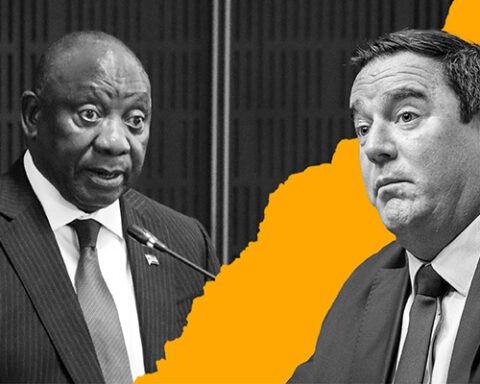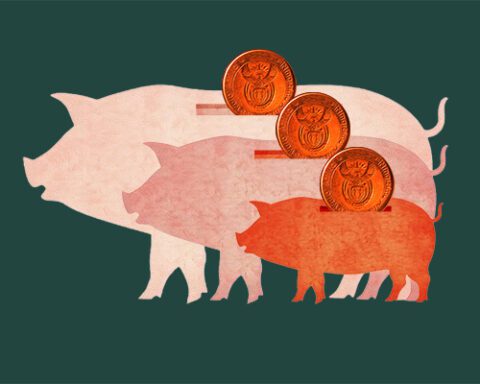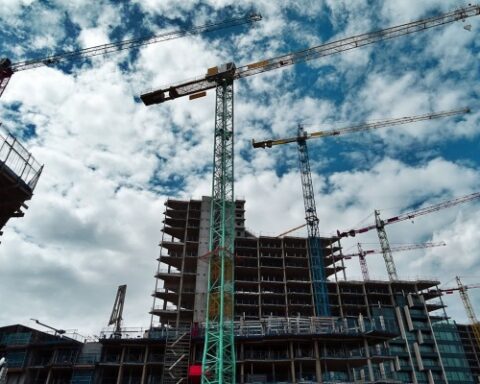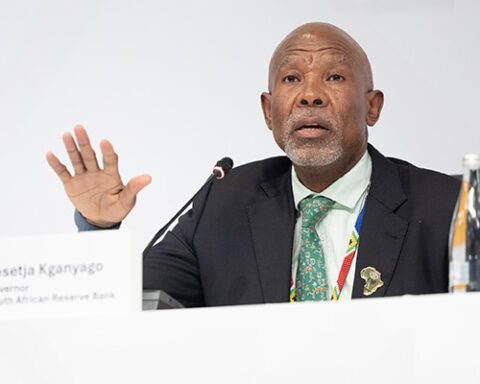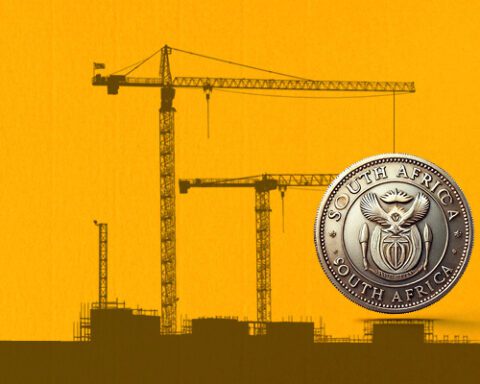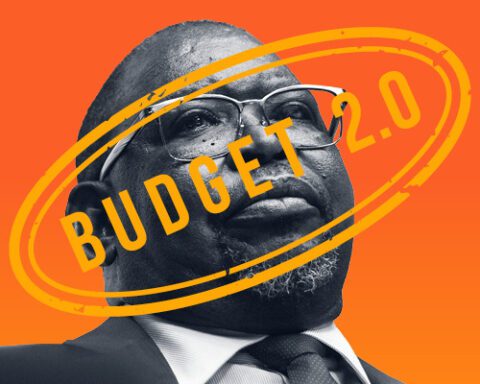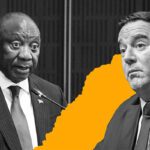In February each year, the finance minister presents the national budget, which outlines the government’s main spending, tax and borrowing plans for the next three years. Of course, that didn’t happen this year, after Enoch Godongwana tried – unsuccessfully – to sneak a two percentage point VAT hike through the coalition government. Which meant a rerun of the whole affair today.
Finding the money to fund the country is no mean feat. Economic growth has been too slow, muddling along at less than 1% for a decade – not enough to address the country’s crippling unemployment rate and poverty. The government has acknowledged this, and has put together what it thinks is a growth-oriented budget.
“Government is implementing reforms to increase infrastructure investment and encourage private sector participation,” the National Treasury said in its People’s Guide to the budget. “These reforms include making it easier for a private company to partner with a government agency to deliver projects, improving how government plans for infrastructure and enhancing the accountability of departments and institutions of the state.”
At the same time, it will extend the Covid relief grant until March next year, while granting above-inflation increases for welfare payments. It is expected that 19.3-million people will receive social grants by March 2028.
Here are 10 other things you need to know from this year’s budget:
1. Eskom debt relief
The Treasury and Eskom have agreed to a new deal that will see the government providing R24bn less in loans than initially planned as part of a bailout in 2023.
In terms of the new plan, a final R70bn debt takeover will now be replaced with two advances amounting to R50bn and R40bn in 2025/26 to redeem debt maturing in April 2026, and R10bn in 2028/29 for debt maturing in May 2028. That cuts the final outstanding amount to R230bn from R254bn, with the original terms to convert the debt into equity still in place.
The agreement was reached “to simplify the final phase of the debt relief – a change that also reflects some improvement in the utility’s financial position flowing from the interventions to date”.
2. Economic growth
The National Treasury is forecasting GDP growth will average 1.8% from 2025 to 2027, reaching 1.9% this year, with the “continued recovery supported by improved investor confidence, stable electricity supply, lower interest rates”, and perceptions that South Africa is less risky contributing towards it paying less to borrow. The economy expanded 0.6% in 2024.
Local risks to the outlook include, logistical challenges and unfunded spending pressures or the “materialisation of contingent liabilities” that the government has set aside for state-owned companies, the Treasury said. On the upside, a faster-than-expected easing in interest rates and inflation would boost consumer spending, as could greater-than-expected withdrawals from the two-pot retirement system.
“Continued stable electricity supply, and progress in reforms, could boost business confidence,” it said, adding that “a rapid uptake of renewable energy investment by the private sector and municipalities could drive stronger growth outcomes over the medium to long term.”

3. Borrowing costs
Government debt is expected to peak at 76.2% of GDP in the financial year through March 2026, worse than the 75.5% forecast in the medium-term budget policy statement in October, falling to 75.1% by fiscal 2028. Crucially, it is also predicted that debt-service costs, which consume almost 22c of every rand of revenue, will stabilise.
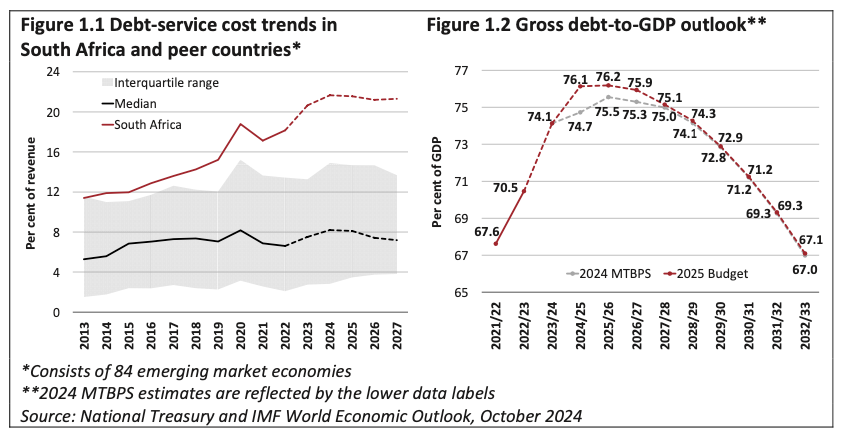
4. Budget shortfall
With estimates showing it will miss its target to bring the consolidated budget deficit down, Treasury is now forecasting that the shortfall will narrow to 3.5% in the 12 months through March 2028. In 2024, Godongwana’s team forecast the gap would shrink to 4.5% for 2024/25; it now estimates this will come in at 5%.
5. Primary surplus
There is good news on another front though. The primary budget surplus, which excludes the weighty interest bills the government carries, is expected to widen to 0.9% of GDP is the 2025/26 financial year, from an estimated 0.5% this year. This means revenue is higher than non-interest expenditure, which is helping efforts to stabilise debt.
While Treasury has adopted a primary budget surplus as its fiscal anchor for the rest of the decade, the government published a discussion document to determine potential “longer-term fiscal anchors” to balance “fiscal sustainability with developmental objectives, so that public resources can be targeted effectively for social and economic impact”.
6. Infrastructure drive
Over the next three years, R1.03-trillion will be allocated to public infrastructure, with most of that going to roads (R402bn), energy (R219.2bn), and water and sanitation (R156.3bn). State-owned companies, public entities and municipalities will fund 73% of that.
A new “structure” will be created and overseen by the Treasury over the next year to co-ordinate state participation in project preparation and planning, public-private partnerships (PPPs), funding and credit guarantees.
At the same time, PPP rules have been streamlined, while the budget has introduced a performance-based conditional grant for trading service entities that provide basic services, such as municipal water, to “incentivise financial and operational reforms” and “improve their functioning and sustainability”.
7. Credit guarantee
The government is preparing a special credit guarantee vehicle that will be used to “mobilise” private capital by derisking critical projects in the energy, transport and water sectors. The “arrangement” is projected to have initial capital of $500m.
8. Green borrowing
As part of its borrowing programme, the Treasury is developing a “sustainable finance framework to raise funding through the issuance of green or sustainability-linked bonds to help deepen capital markets on the continent and ensure a diversified portfolio of instruments”.
9. Property inflation
Transfer duties for properties have been adjusted by 10% to compensate for inflation, and will become effective from April. The transfer duty tax rates will remain unchanged.
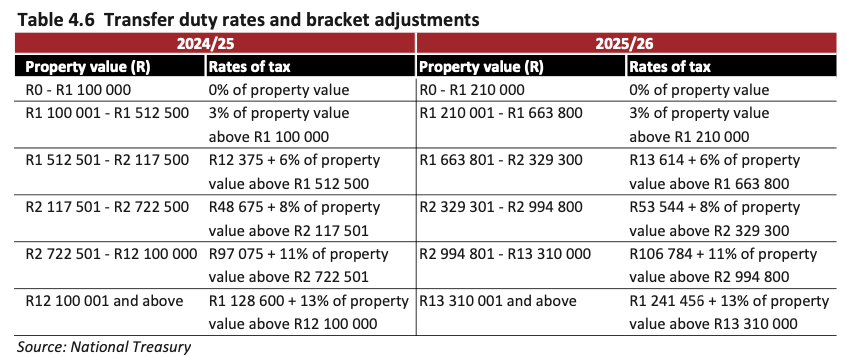
10. Renewable energy allowance
A temporary incentive that fell away at the end of February for the leasing provisions and the generation threshold of 1MW will be restored.
Another talking point
The Treasury is considering changes to the rules that currently exempt lump sums, pensions and annuities from foreign retirement funds for South African residents’ previous employment outside the country. The current treatment of cross-border retirement funds may result in double non-taxation, particularly where South Africa is granted the taxing right by treaty.
Read Godongwana’s budget speech here:
Sign up to Currency’s weekly newsletters to receive your own bulletin of weekday news and weekend treats. Register here.

